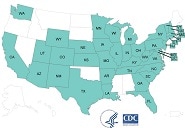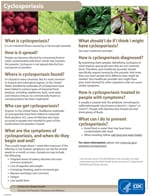Domestically Acquired Cases of Cyclosporiasis — United States, May–August 2019
Last Updated NOVEMBER 19, 2019 4:00 PM EDT
While cyclosporiasis cases are reported year-round in the United States, cyclosporiasis acquired in the United States (i.e., “domestically acquired”, or cyclosporiasis not associated with travel to a country that is considered endemic for Cyclospora) is most common during the spring and summer months. The exact timing and duration of U.S. cyclosporiasis seasons can vary, but reports tend to increase starting in May. In previous years the reported number of cases peaked between June and July, although activity can last as late as September. The overall health impact (e.g., number of infections or hospitalizations) and the number of identified clusters of cases (i.e., cases that can be linked to a common exposure) also vary from season to season. Previous U.S. outbreaks of cyclosporiasis have been linked to various types of imported fresh produce (e.g., basil, cilantro, mesclun lettuce, raspberries, and snow peas).
Final Update
- In 2019, multiple outbreaks of cyclosporiasis were identified and found to be linked to different produce items.
- As of November 13, 2019, 2,408 laboratory-confirmed cases of cyclosporiasis were reported to CDC by 37 states, District of Columbia, and New York City in people who became ill during May 1 to August 31, 2019 and who had no history of international travel during the 14-day period before illness onset.
- The median illness onset date was July 1, 2019 (range: May 1–August 31, 2019).
- At least 144 people were hospitalized; no deaths were reported.
- Multiple clusters of cases associated with different restaurants or events were investigated by state public health authorities, CDC, and FDA.
- Approximately 10% of ill people were associated with a multistate outbreak of Cyclospora infections linked to fresh basil imported from Siga Logistics de RL de CV of Morelos, Mexico.
- Many cases of cyclosporiasis could not be directly linked to an outbreak, in part because of the lack of validated molecular typing tools for C. cayetanensis, the parasite that causes cyclosporiasis.
- The overall number of domestically acquired cases reported to date for May–August 2019 (i.e., 2,408) is higher than the numbers of cases reported for the same period in 2017 and 2018. This increase may be due, in part, to changes in diagnostic testing practices—namely, increased use of a multiplex molecular test to examine stool specimens. CDC is working with state public health partners to determine whether and to what extent changes in testing practices may have contributed to increased case detection and reporting.
- States reporting cases: 37
- Deaths: 0
- Hospitalizations: 144
Geographic Distribution of Reported Cases of Domestically Acquired Cyclosporiasis with Illness Onset May–August, 2019
- CDC and partners work to prevent cyclosporiasis outbreaksexternal icon
- Cyclospora Information
- Investigating Foodborne Outbreaks
- Advanced Molecular Detection for Cyclospora
- Time to Think About Cyclosporiasisexternal icon (Medscape)
- CDC: 2017 Health Alert Network (HAN) Advisory (for health-care providers)

